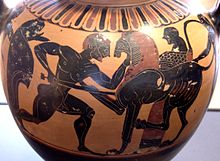Pseudo-Chalcidian vase painting

The pseudo-chalkidian pottery is an important genus of black-figure Greek vase painting in the 6th century. Chr.
The pseudo-Chalcidian vase painting is based strongly on the Chalcidian vase painting . But it also shows strong references to Attic and Corinthian vase painting . The artists here do not use the Chalcidian but the Ionic alphabet for inscriptions. In addition, the vases have a different tone quality. Today around 70 vases of the genus are known, which were first put together by Andreas Rumpf . The artisans may be the successors of the Chalcidian vase painters and potters who immigrated to Etruria . Another explanation for the differences between Chalcidian and pseudo-Chalcidian vases would be different workshop traditions and access to other clay deposits, which made certain technical variations necessary.
The pseudo-Chalcidian vase painting can be divided into two groups. The older of the two groups is the Polyphemus group . It also represents the greater part of the surviving works. The preferred vase shapes were mainly neck amphorae and oinochoa . Usually groups of animals are shown, rarely mythical images ( Herakles , Hephaestus ). The vessels were found in Etruria and Sicily, but also in Marseille and Vix . The younger and less productive Memnon group , to which 12 vessels are currently assigned, had a much smaller distribution area, which was limited exclusively to Etruria and Sicily. Except for one oinochoe, they only produced neck amphoras, which were mostly painted with animals and riders. Once a carriage ride is shown, as well as an amphora with Odysseus and Kirke .
literature
- Andreas Rumpf : Chalcidian vases. Using the preliminary work by Georg Loeschcke . de Gruyter, Berlin et al. 1927.
- Fulvio Canciani: A new amphora from Vulci and the problem of the pseudochalkidian vases. In: Yearbook of the German Archaeological Institute . Vol. 95, 1980, pp. 140-162.
- Mario Iozzo : Ceramica “calcidese”. Nuovi documenti e problemi riproposti (= Atti e memorie della Società Magna Grecia. Series 3, Vol. 2, ISSN 1592-7377 ). Società Magna Grecia, Rome 1994.
- Thomas Mannack : Greek vase painting. An introduction. Theiss, Stuttgart 2002, ISBN 3-8062-1743-2 , p. 131.
- Matthias Steinhart : Pseudochalkidic vase painting. In: The New Pauly (DNP). Volume 10, Metzler, Stuttgart 2001, ISBN 3-476-01480-0 , Sp. 516 f.
